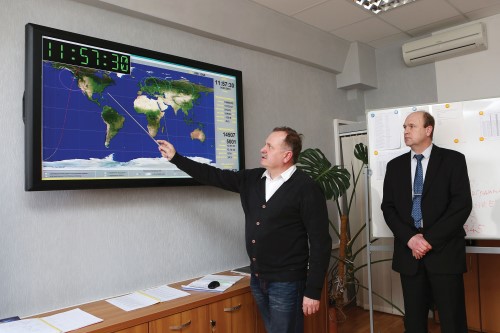Russian and Belarusian National Academies of Sciences to jointly construct inter-academic satellite
Plasma is a high-temperature state, widespread in nature: across the cosmos and the universe. Scientists have managed to tame this unstable and unpredictable substance, such as via nuclear weapons, plasma TV panels and diverse technologies of metal strengthening and processing.

Vladimir Gusakov and Vladimir Fortov are convinced that
co-operation between their academies will significantly
enhance the scientific potential of the Union State
Belarus boasts one of the most advanced scientific schools in this sphere, initiated by outstanding researcher and USSR Lenin Award holder Mikhail Yelyashevich. His followers work in several academic institutions and universities countrywide.
A recent international conference on plasma physics — hosted by Belarus’ National Academy of Sciences — brought together leading world scientists and promoted modern developments at the highest level. Besides welcoming experts from the USA and Asia, it hosted a large delegation led by the President of the Russian Academy of Sciences, Vladimir Fortov. It was his first visit to Minsk as the head of the RAS. “The global equipment market widely uses plasma; one of the largest markets accounts for $3-4 trillion,” he told journalists. “Importantly, Belarus has not only preserved studies in this field but has mastered production based on these scientific results.”
Our two states’ scientists closely co-operate in this high-tech sphere: for example, Belarusian researchers visit their Russian colleagues to conduct major experiments. Following the exchange of experience at the Minsk conference, new co-operative agreements on plasma studies are expected to be signed.
Mr. Fortov and his Belarusian colleague, the Chairman of the National Academy of Sciences’ Presidium, Vladimir Gusakov, discussed a wide range of issues. Of course, our academies liaise not only in the field of plasma but meet regularly as an inter-academic council. On June 16th, Moscow hosted a joint session of the two academies of sciences’ presidiums, with a plan of co-operation signed for the coming five years. Special attention was paid to forming a mechanism of selection for the most important Belarusian-Russian programmes, with focus on such vital aspects as remote Earth monitoring. A framework agreement was signed recently: on co-operation in creating a new Belarusian satellite (to be launched in coming years).

At the Belarusian spacecraft flight control centre
At the Minsk conference, the two academies’ heads decided to create a joint inter-academic satellite. Mr. Gusakov explains, “We intend a micro-satellite: size doesn’t matter for science and education. We could launch it via a cargo or piloted spacecraft, rather than a special rocket, which would be much simpler and cheaper.”
Mr. Fortov also visited the permanent show of Belarusian academic science’s achievements. Around 30 percent of its exhibits have been created as part of joint Union State sci-tech programmes, covering informatics, microelectronics, and bio- and nano-technologies.
The launch of the first Belarusian nuclear power station — being built by Russian companies, under a Russian project — will launch a new stage of collaboration. Belarusian research organisations are already conducting a scientific accompaniment to this important project and plan to work in this field further — relying on great Russian experience in the nuclear sphere.
By Vladimir Yakovlev











